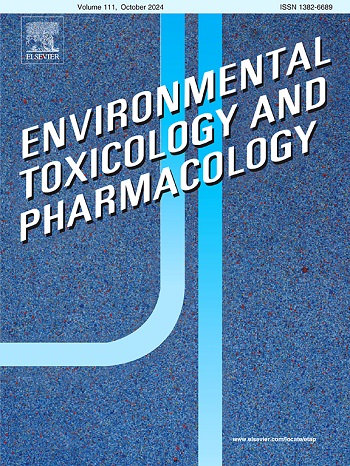黄曲霉毒素b1暴露对黑兵蝇、家蝇和小粉虫幼虫提取物遗传毒性的影响
IF 4.2
3区 环境科学与生态学
Q2 ENVIRONMENTAL SCIENCES
引用次数: 0
摘要
黄曲霉毒素B1 (AFB1)污染的作物可作为昆虫饲料,对黑兵蝇(BSFL)、家蝇(HFL)和小粉虫(LMW)幼虫的生长和存活没有影响。然而,在afb1污染的基质上饲养的幼虫的遗传毒性安全性仍不确定。本研究通过体外试验评估了0、20和200µg/kg AFB1加标底物饲养的幼虫的遗传毒性作用。采用LC-MS/MS-based方法分析饲料底物、幼虫和残留物质中的AFB1及其代谢物。使用Ames MPFTM试验(mini-Ames试验)、Ames试验和体外微核试验评估幼虫提取物的细胞毒性和基因毒性潜力。结果:对所有昆虫的生存和生物量均无影响,AFB1无生物蓄积。似乎发生了物种特异性AFB1代谢。HFL无细胞毒性和基因毒性。由于基质效应和与体外试验不相容,BSFL和LMW有待进一步研究。本文章由计算机程序翻译,如有差异,请以英文原文为准。
Impact of aflatoxin B1-exposure on the genotoxic potential of larval extracts of the black soldier fly (Hermetia illucens), housefly (Musca domestica) and lesser mealworm (Alphitobius diaperinus)
Aflatoxin B1 (AFB1)-contaminated crops could serve as insect feed without affecting growth and survival of black soldier fly (BSFL), housefly (HFL), and lesser mealworm (LMW) larvae. However, the genotoxic safety of larvae reared on AFB1-contaminated substrate remains uncertain. This study assessed the genotoxic effects of larvae reared on 0, 20, and 200 µg/kg AFB1 spiked substrate through in vitro testing. AFB1 and metabolites were analysed in the feed substrate, larvae and residual material using a LC-MS/MS-based method. Cytotoxic and genotoxic potential of larval extracts were assessed using the Ames MPF™ assay (mini-Ames assay), Ames test, and in vitro micronucleus assay.
Results
indicated no effect on survival and biomass for all insects and no bioaccumulation of AFB1. Species-specific AFB1 metabolism appeared to occur. HFL exhibited no cytotoxic or genotoxic potential. Further research is required for BSFL and LMW, due to matrix effects and incompatibility with the used in vitro tests.
求助全文
通过发布文献求助,成功后即可免费获取论文全文。
去求助
来源期刊
CiteScore
7.00
自引率
4.70%
发文量
185
审稿时长
34 days
期刊介绍:
Environmental Toxicology and Pharmacology publishes the results of studies concerning toxic and pharmacological effects of (human and veterinary) drugs and of environmental contaminants in animals and man.
Areas of special interest are: molecular mechanisms of toxicity, biotransformation and toxicokinetics (including toxicokinetic modelling), molecular, biochemical and physiological mechanisms explaining differences in sensitivity between species and individuals, the characterisation of pathophysiological models and mechanisms involved in the development of effects and the identification of biological markers that can be used to study exposure and effects in man and animals.
In addition to full length papers, short communications, full-length reviews and mini-reviews, Environmental Toxicology and Pharmacology will publish in depth assessments of special problem areas. The latter publications may exceed the length of a full length paper three to fourfold. A basic requirement is that the assessments are made under the auspices of international groups of leading experts in the fields concerned. The information examined may either consist of data that were already published, or of new data that were obtained within the framework of collaborative research programmes. Provision is also made for the acceptance of minireviews on (classes of) compounds, toxicities or mechanisms, debating recent advances in rapidly developing fields that fall within the scope of the journal.

 求助内容:
求助内容: 应助结果提醒方式:
应助结果提醒方式:


